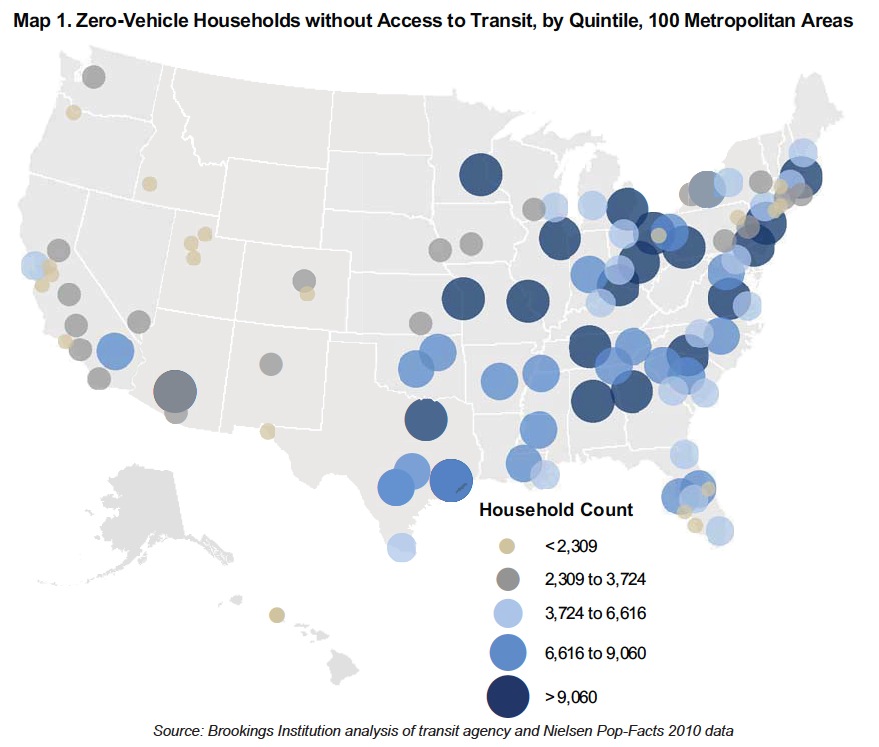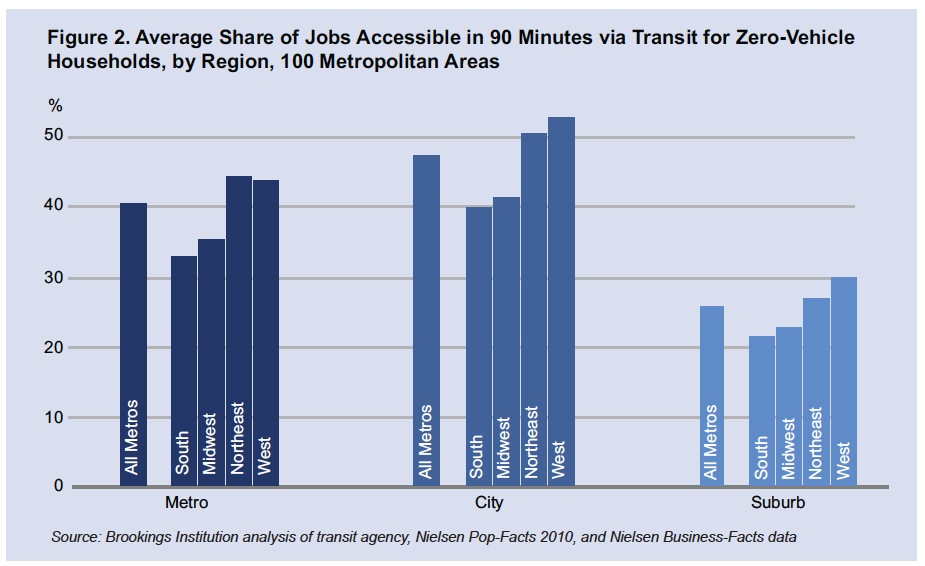BROOKINGS INSTITUTION
Introduction
Americans possess a well-documented dependency on the automobile—and nowhere is that clearer than in how Americans travel to work. Over three-quarters of commuters drive alone to work, with another 10 percent carpooling. Considering that Americans registered over 133 million private and commercial vehicles in 2009, it makes sense that so many people would drive. However, there remain over 10 million American households who do not own a private vehicle.
Not only do these households live without access to a personal vehicle, but these zero-vehicle households also must commute in an employment environment particularly unsuited to their travel options. The United States added over 655,000 roadway lane miles since 1980, leading to the rapid decentralization of housing and jobs. Such decentralization leaves a zero-vehicle household’s most likely travel modes—transit, walking, and biking—at a structural disadvantage due to ever growing distances between locations.
For some, not owning a vehicle represents a lifestyle choice. Such individuals may live in locations where car ownership is particularly expensive or impractical, and there are plentiful transportation alternatives for accessing jobs and meeting other household needs. As explained below, however, census data imply that the majority of these zero-vehicle households face economic constraints to automobile ownership. Not only are cars themselves expensive, but households with lower incomes may also face higher costs for financing a car. Used cars offer a cheaper sticker price but tend to incur higher annual operating costs. Not owning a car may impart further economic disadvantage as well, as workers with cars work more hours per week than those without cars, enabling them to earn higher incomes.
Based on these environmental and economic disadvantages, public policy has a responsibility to improve transportation accessibility for zero-vehicle households. First, it should ensure that people who are most constrained in their transportation choices—low-income zero-vehicle households—have access to viable transportation options. Second, it should expand transportation options for all households, including those who can afford a car but choose not to, because of the attendant environmental and economic benefits.
To meet these responsibilities, policymakers need a strong understanding of zero-vehicle households’ geographic distribution and demographic characteristics. That understanding should inform the response of metropolitan transit systems to these households’ transportation needs. Brookings’ “Missed Opportunity” report found that large metropolitan areas face a transit paradox. Transit agencies offer at least basic fixed route transit service to a majority of their working-age population, but those same services fall short on connecting workers to jobs. Do zero-vehicle households face this same paradox?
This brief begins by prof ling zero-vehicle households: who they are, what they earn, and where they live. Next, using a comprehensive “supply side” transportation model, the brief examines how many zero-vehicle households have an opportunity to use transit and if that service helps them reach metropolitan job opportunities. It concludes with a discussion of the implications for public policy.
Download the full version (PDF): Transit Access and Zero-Vehicle Households
About Brookings Institution
www.brookings.edu
“The Brookings Institution is a nonprofit public policy organization based in Washington, DC. Our mission is to conduct high-quality, independent research and, based on that research, to provide innovative, practical recommendations that advance three broad goals:
* Strengthen American democracy;
* Foster the economic and social welfare, security and opportunity of all Americans and
* Secure a more open, safe, prosperous and cooperative international system.
Brookings is proud to be consistently ranked as the most influential, most quoted and most trusted think tank.”
Tags: Brookings Institution, Transit Access and Zero-Vehicle Households








 RSS Feed
RSS Feed